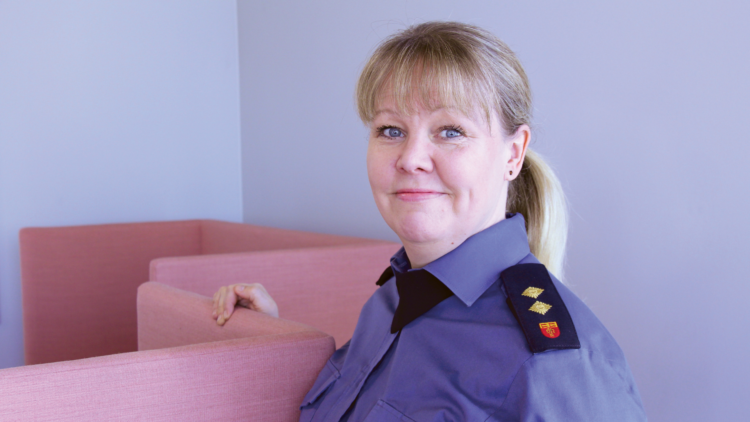Charge and use safely – expert safety tips for daily life

Safety communication expert Tanja Nyqvist trains people of all ages about rescue skills and everyday safety, and always encourages her listeners to think of examples from their own daily lives.
– Fortunately, not many people cause fires deliberately, but we can make mistakes. Nyqvist knows that when we are busy in our daily lives, we don’t always remember to think about the risks.
Almost everyone has a smartphone in their pocket, but electric scooters and electric bicycles are also becoming a lot more common. When used and charged carefully and according to the instructions, the devices are safe, but there is always a risk associated with electric and battery-powered devices.
A battery will burn explosively if it catches fire, and flames will shoot out the sides and upwards, which means that a fire can quickly spread.
A battery fire is extinguished by cooling. If, for example, the battery of a phone or electric scooter catches fire, the entire device or at least the battery should be submerged in water. Putting out electric car fires is very challenging, however, precisely because it is difficult to cool the battery let alone submerge it in water.
– Because the gas emissions produced by a battery fire are life-threatening, it is important to quickly leave the scene of a fire, Nyqvist advises.

Charge safely and securely
Nyqvist recommends, for example, that the battery of an electric scooter or electric bicycle be charged and stored on a non-flammable surface. At the same time, care should be taken that the battery is far enough away from combustible materials.
– When thinking about where to store a battery, it is good to consider how any potential fire could be prevented from spreading.
Of course, the same also applies to smartphones and computers.
– Many people charge their phones next to the bed or even on the bed, and fires have started from such places. Under no circumstances should you leave the device charging overnight.
When disconnecting the device from the charger, the cord should also be disconnected from the plug. A cord left lying on the floor or a table, when the cord is connected to a power outlet, poses a danger to pets and small children, for example.
Protect batteries from shock
Nyqvist knows that many people want to bring their expensive electric bike or scooter inside for the night so that it is safely stored. However, in the hallway under a coat rack, the device poses a risk, because if it catches fire, it blocks the occupant’s escape route.
– It wasn’t long ago when an electric scooter that was brought into an apartment in Vaasa caught fire. Fortunately, the owner quickly got the battery out of his room and the building, and the fire did not spread.
Nyqvist also knows of a case where a smartphone caught fire in a trouser pocket. The phone and its battery had been hit by some keys in the same pocket. Although the probability of a fire is small, there is always a risk.
– This person had already suffered really bad burns by the time he managed to get his trousers off.
In the same way, risk can lurk in a backpack or handbag: papers, a thermos or water bottle, keys, cosmetics, a computer and phone can create a cocktail that, with bad luck, can start a fire with an unfortunate knock. Good protective covers for devices and their own protective bags not only extend the useful life of electronics, but also increase the safety of daily life.
Tanja Nyqvist’s tips for a safe home
A clean kitchen is a safe kitchen
“Half of fires in buildings are caused by people. The most common cause of a fire can be found in the kitchen, the stove or in its immediate vicinity. Grease accumulated in a stove’s crevices or in a stove’s extractor fan can catch fire, as can items left too close or even on top of the stove.”
Disconnect the fuse if the sauna is not in use
“Disconnect the fuse If you have a sauna, but it’s full of things. Then children playing, pets, or objects being moved in the sauna cannot accidentally switch on the heater and cause a fire.
Test the smoke detector once a month
“A smoke detector is a technical device whose functionality deteriorates over time. Invest in a new alarm in time. In tests by the Finnish Safety and Chemicals Agency, it was found that although the test sound still worked, some devices no longer reacted to smoke.”
Make sure that fire-fighting equipment and first-aid supplies are easily accessible
“It’s not a good idea to keep a fire blanket or handheld fire extinguisher in a cupboard, where you have to look for it in an emergency. Make sure that everyone in the home knows where the fire extinguishers and first aid equipment are and how to use them.”
Always place candles on a non-flammable surface
“When winter and darkness come, many people burn outdoor candles and lanterns. They, like candles, should always be placed on a non-flammable surface. LED candles are a safer option.”
Keep escape routes clear
“If a fire breaks out, you have to get out of the home quickly. Make sure, for example, that there are no extra obstacles in front of the patio door or the window above a fire escape, and that the handles needed to open a window or door are in place.”

